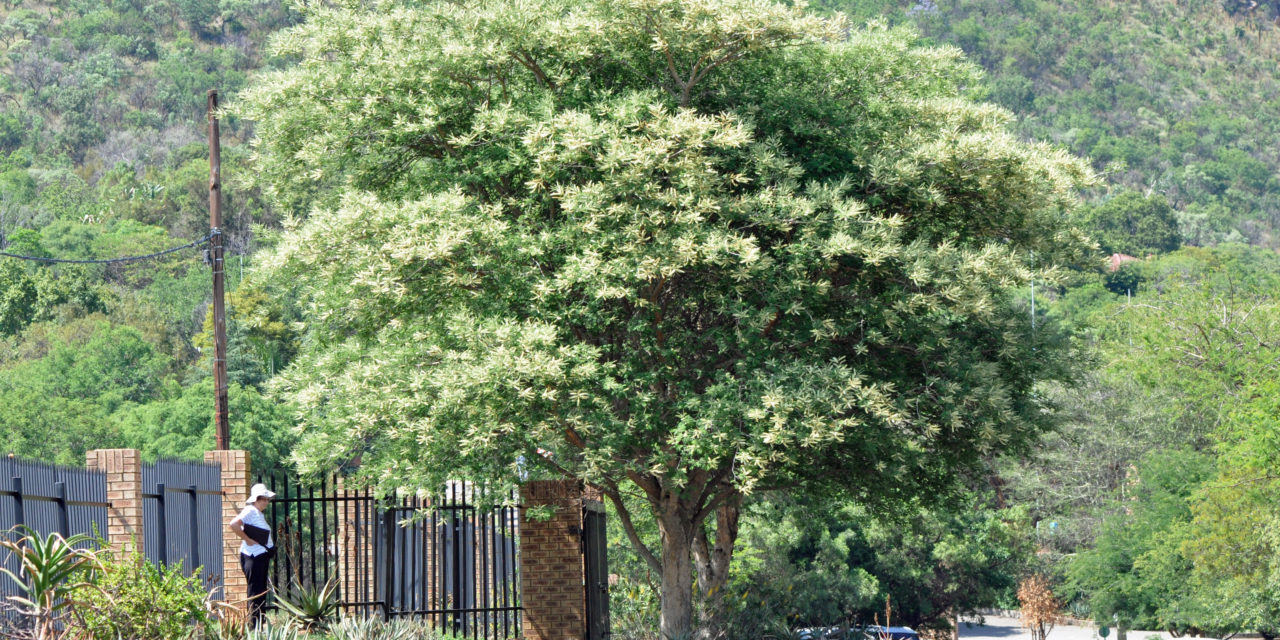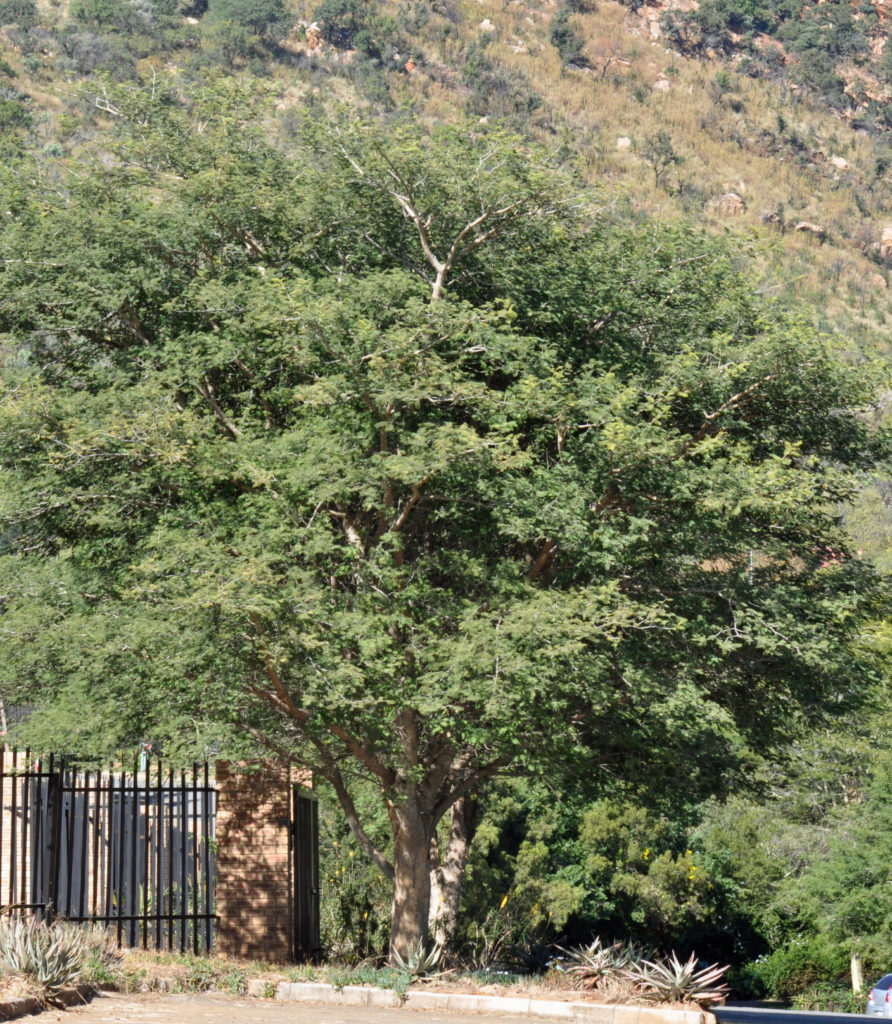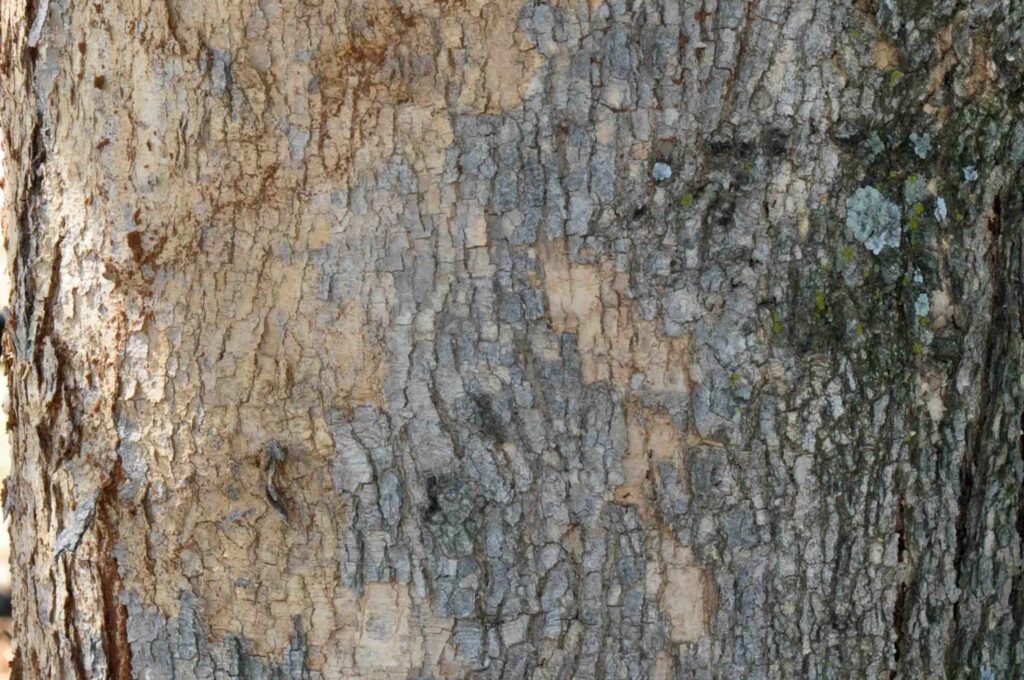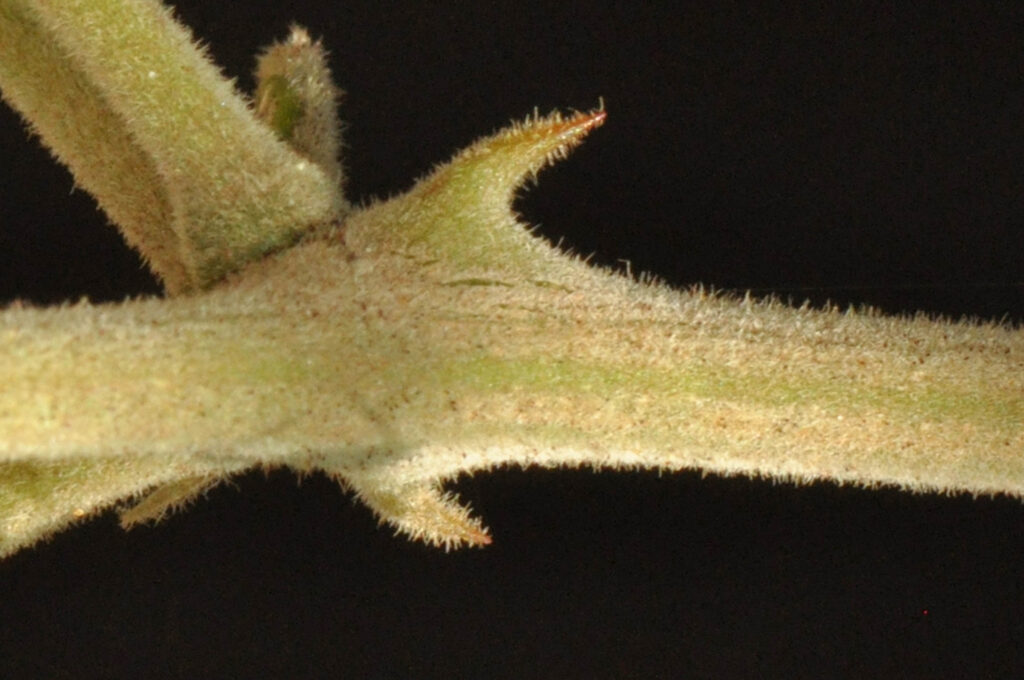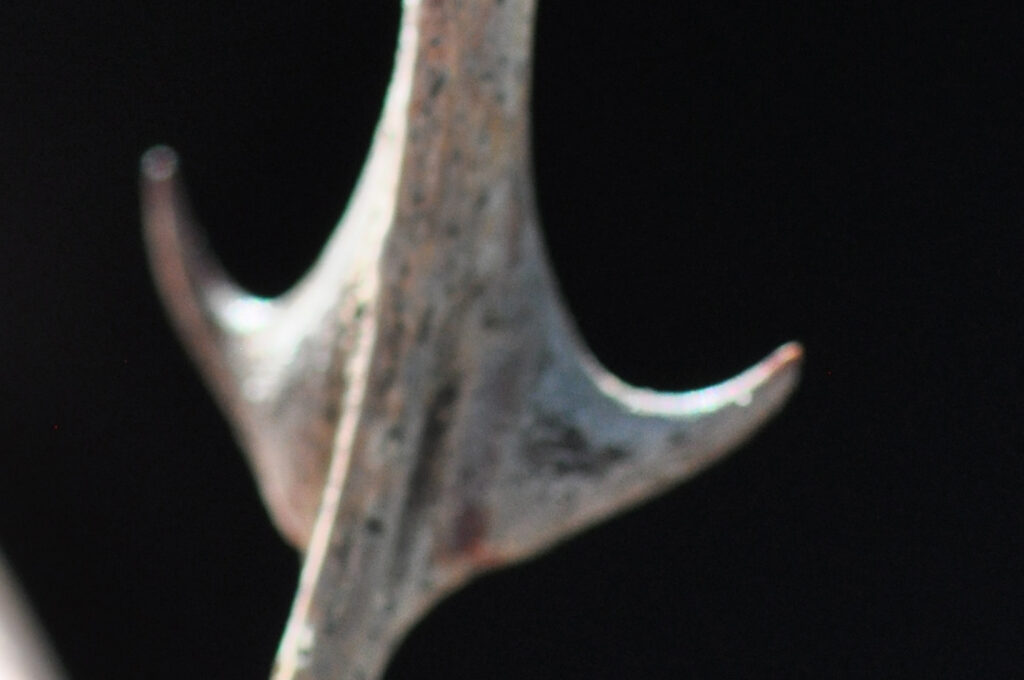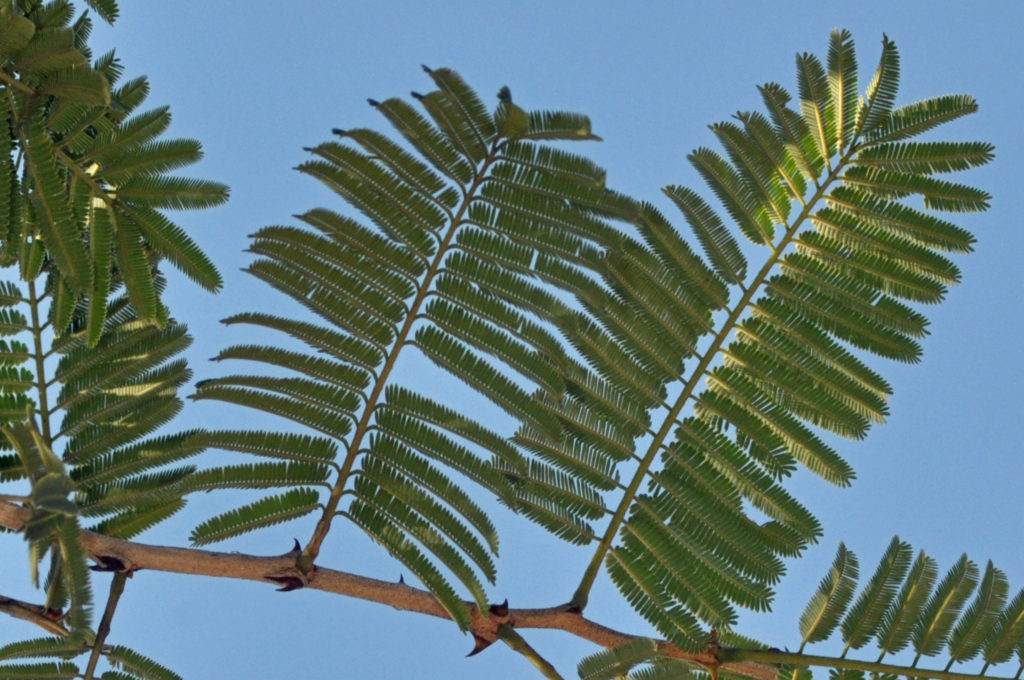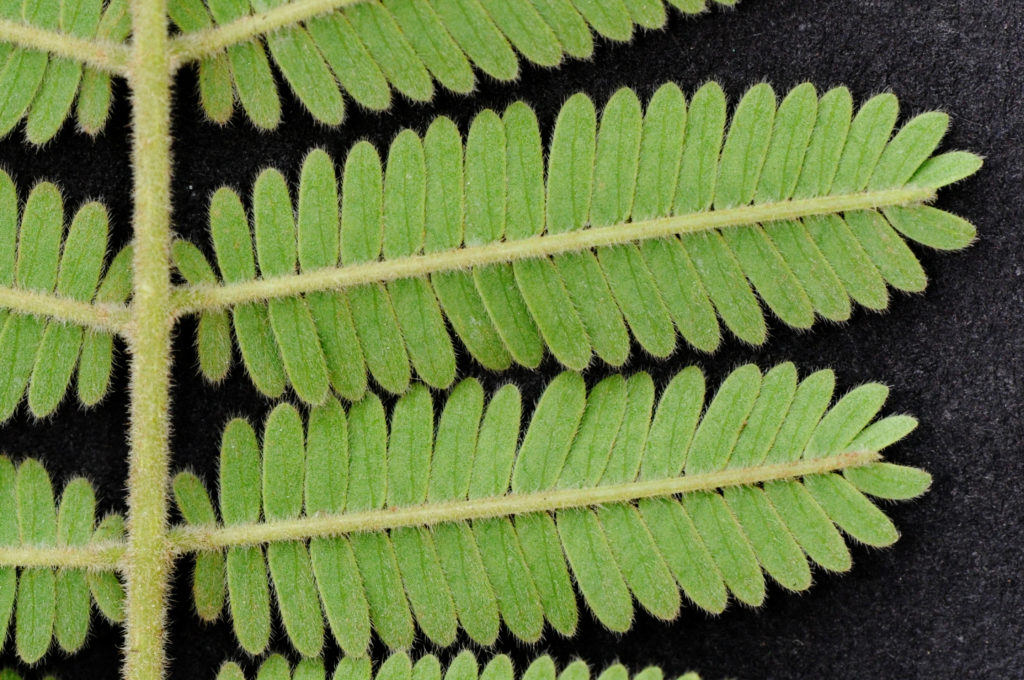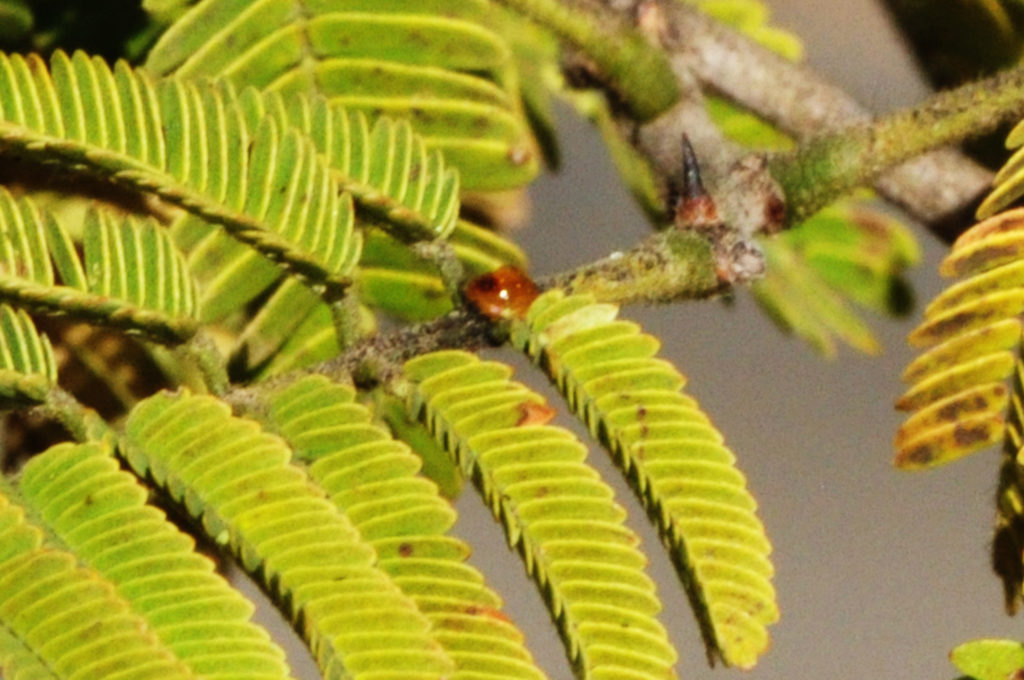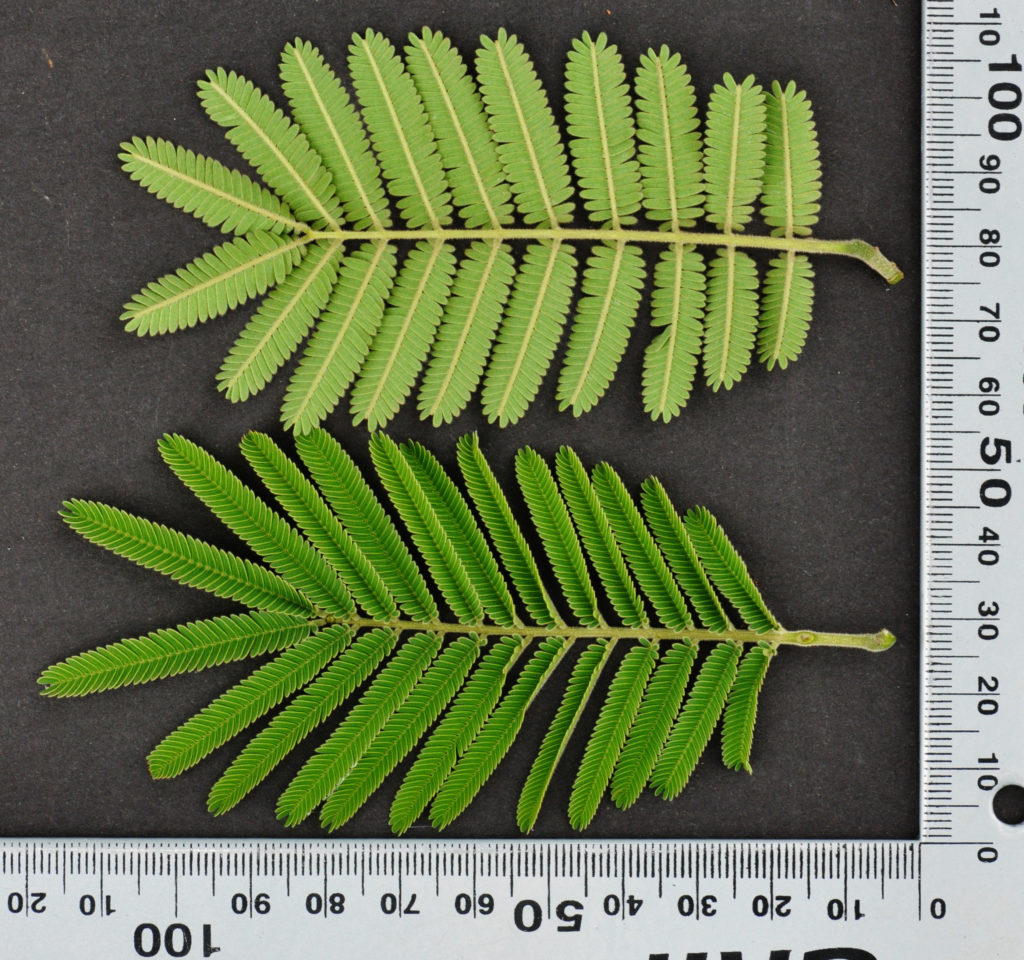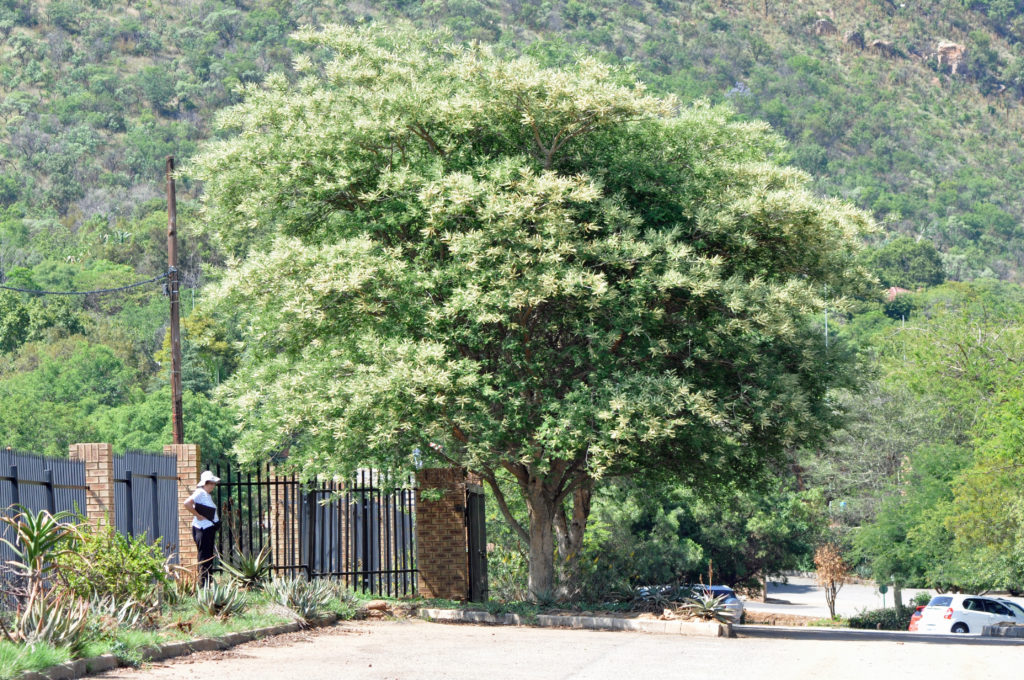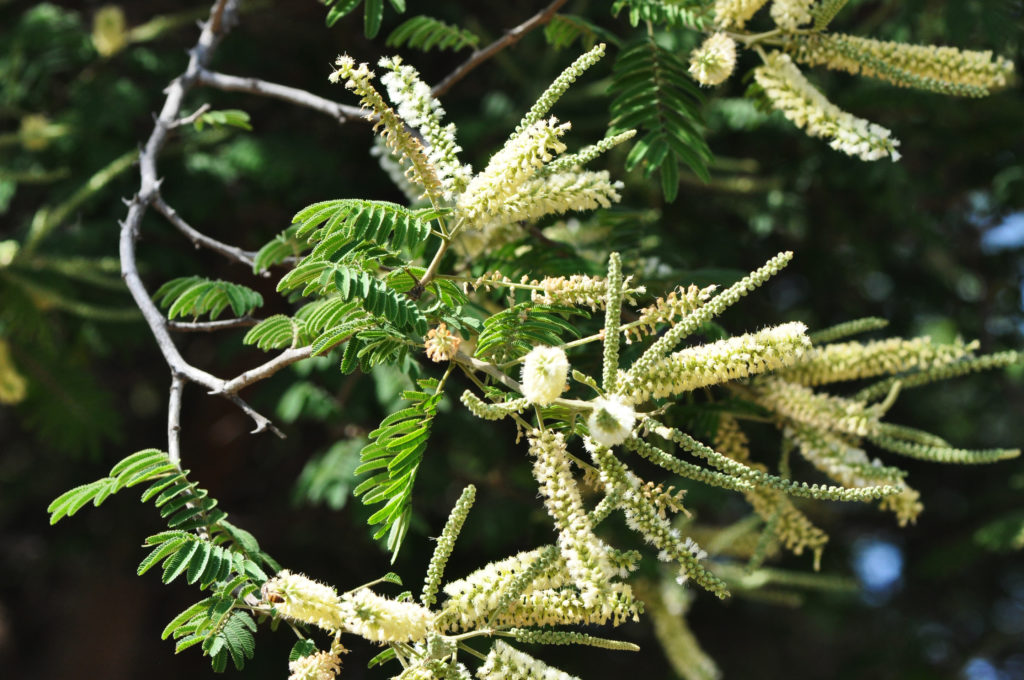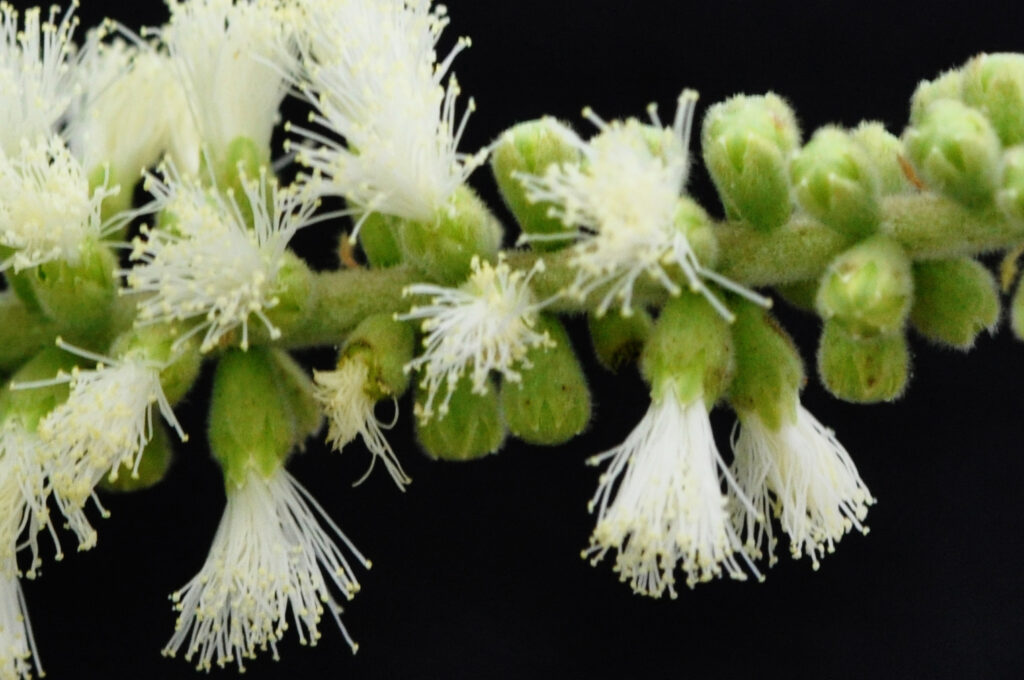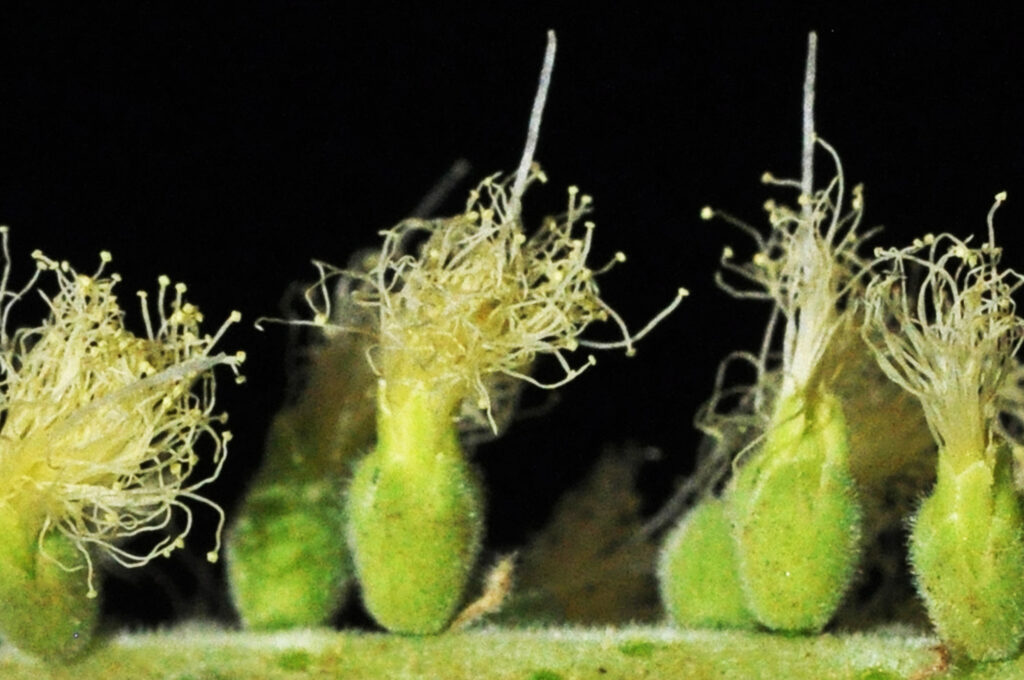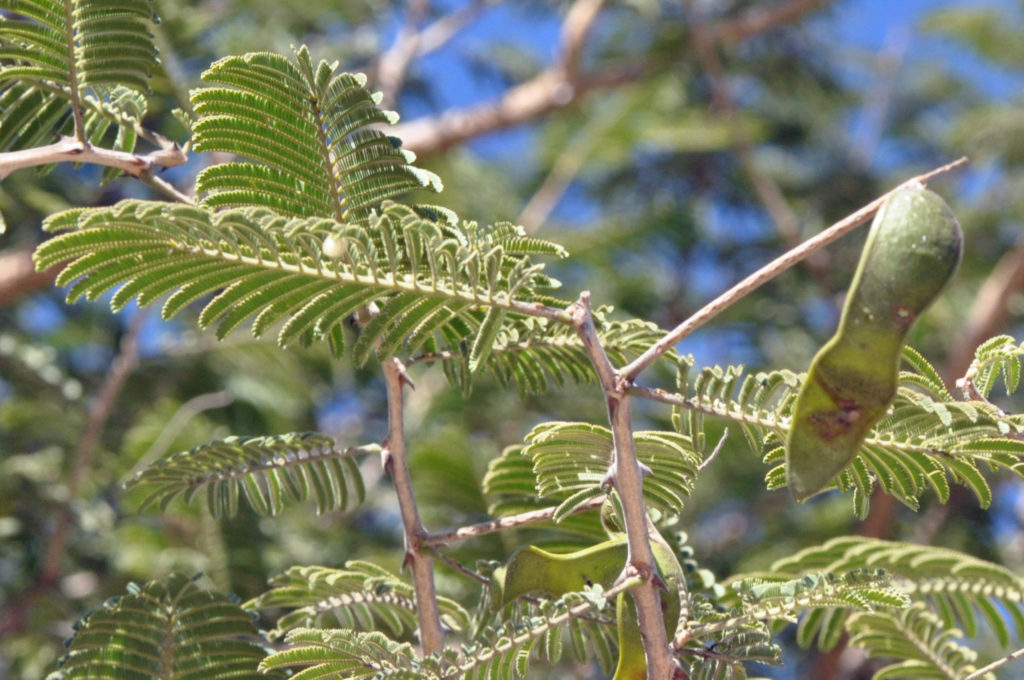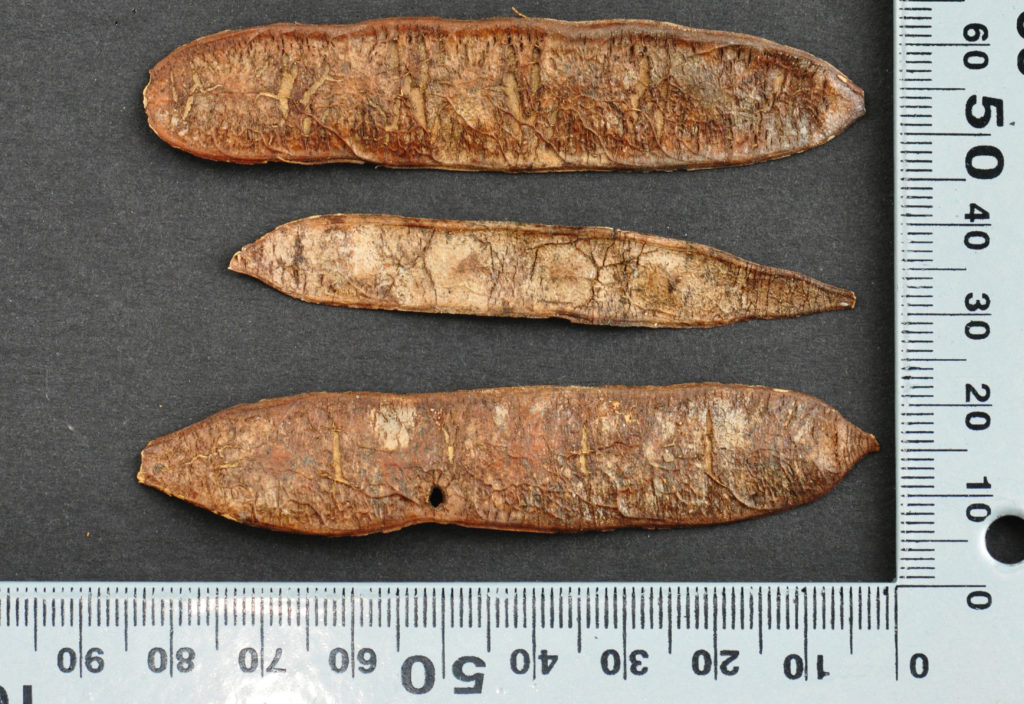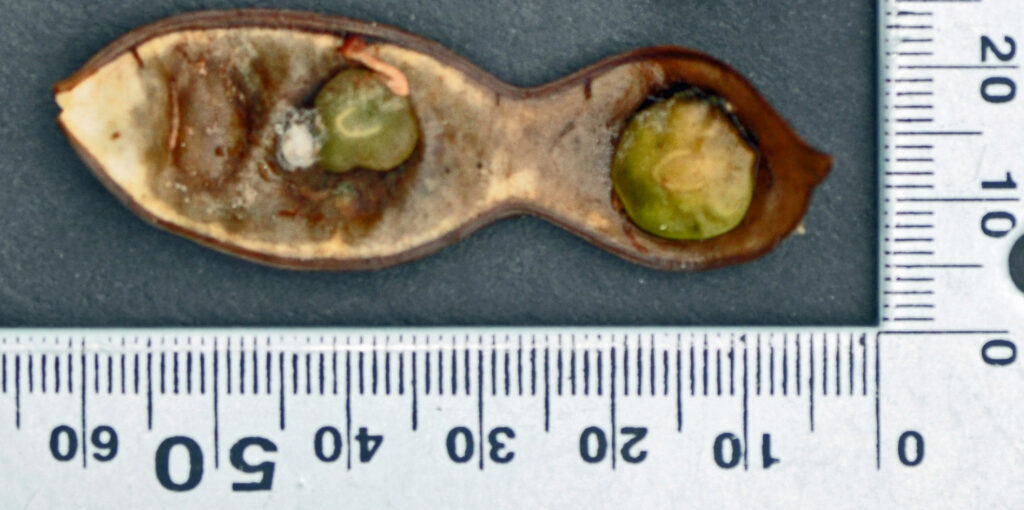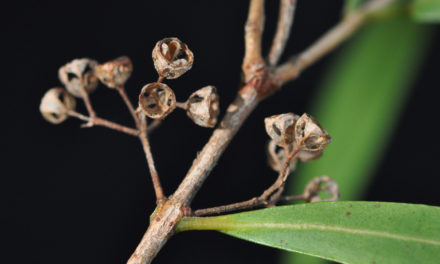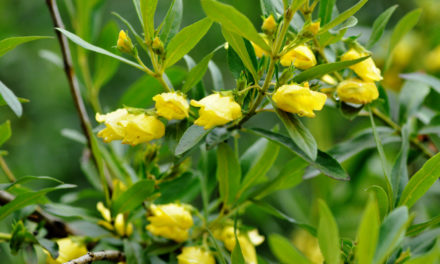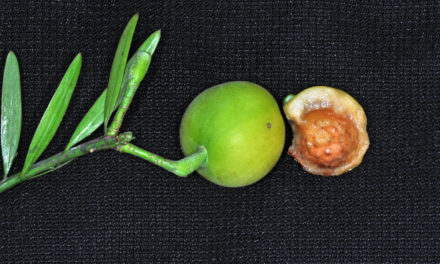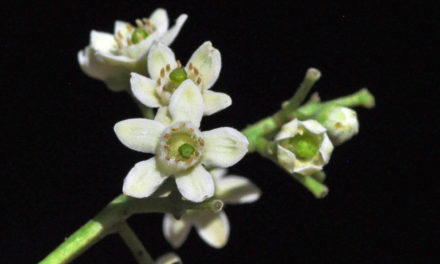General Info – summary
Tree: single trunk is up to 10m high or multi-stemmed. Sharp, paired & curved spines present. The hairy, bipinnate Leaves have non-spinescent stipules and tiny leaflets are closely packed. The bisexual, regular Flowers are in spikes with exserted white filaments for colour. Female: single pistil with a superior ovary has an extending stigma. Fruit: straight dehiscent pod has compressed seeds with horseshoe markings.
Description
Senegalia cinerea
Previous Names: Acacia fleckii, Acacia cinerea, Acacia catechu.
SA Tree No. 165.
Common names: (Afr) Bladdoring, Bladdoring Boom, Bladdoringboom, Plaatdoring. (Eng) Blade Thorn, Plate Thorn, Plate-thorn. (Northern Sotho) Mooka. (Setswana) Mfafu, Mhahu, Mophoka.
Family: Fabaceae or Leguminosae (Pea, bean or legume family). After the Orchidaceae and the Asteraceae, the Fabaceae is the third largest Angiosperm (flowering plants) family with 700+ genera and close to 20 000 species. Local Tree genera on this website include Acacia (Vauchellia, Senegalia), Albizia, Bauhinia, Bolusanthus, Burkea, Calpurnia, Colophospermum, Cordyla, Cyclopia, Dichrostachys, Erythrina, Erythrophleum, Faidherbia, Indigofera, Mundulea, Peltophorum, Philenoptera, Piliostigma, Schotia and Xanthocercis. The Fabaceae are recognisable by their fruit and by their pinnately compound Leaves. Leaves may also be simple – even bilobed and usually have stipules – some of which may be spinescent. Leaflets are usually entire. Flowers are bisexual and bracteate. Regular flowers usually have 4-5 sepals and the same number of petals. Irregular flowers have 4-5 sepals and 5 or less petals. Stamens have anthers that have 2 pollen sacs and there are usually at least twice the number of stamens as petals – often 10. The superior Ovary has one locule that may contain 1 or more ovules. The Stigma and Style are simple. The single carpel develops into the Fruit, which is usually a pod. This pod dehisces on both sides and may break into segments. Seeds vary.
Name derivation. Species of the genus Vachellia and Senegalia were considered members of the genus Acacia until 2005. New Names. The genus Vachellia was named after George H. Vachell (1789 – 1839), chaplain and plant collector in China. Here the inflorescence is capitate (head like) and spinescent stipules are present. Plants in the genus Senegalia – (from Senegal) usually do not have spinescent stipules and the inflorescence is usually a spike. cinerea – ash coloured – referring to the trunk.
Conservation: National Status: L C. (Least Concern). Assessment: 2005 (W. Foden & L. Potter).
Tree
Supporting the round or spreading crown of this Tree (photo 40) is a straight trunk – up to 10m high and 30cm wide. The plant may also be a multi-stemmed shrub and may form impenetrable thickets. The light grey to creamy Bark (photo 40) may be smooth or rough and sometimes flakes in small papery pieces (photo 38). Before they mature, Young branches are initially very hairy (photo 56). Just below the node are initially hairy, paired and sharply hooked, Thorns (photo 620) up to 1cm long. They become, strong, hairless, with a broad base, and develop brown or blackish thorns. These numerous vicious thorns occur just below the nodes (photo 14 – under Leaves). Single thorns with a broader base may also occur.
- 40. 2014/04/29. Walter Sisulu NBG. Photo: D. Becking.
- 38. 2014/04/29. Walter Sisuu NBG. Photo: David Becking.
- 56. 2014/12/02. Walter Sisulu NBG. Photo D. Becking.
- 620. 2015/10/27. Walter Sisulu NBG. Photo D. Becking.
Leaves
The hairy Leaves are Bipinnate (Compound: twice pinnate. The central axis or rachis has lateral “branches” not leaflets and the leaflets are on these “side branches”). Leaves are up to 12cm long and densely ranked (photo 14). The Rachis (main axis, bearing flowers or leaflets) is glandless. Rachillae (secondary rachis: higher order in leaves that are compound more than once) are very short. Each of the 8-20 pairs of pinna has 12-35 pairs of very small pinnules (Leaflets photo 647). The close by leaflets are straight or almost so and up to 5 x 1,3mm (photo 644). The Margins are usually hairy. The hairy Petiole (leaf stalk – photo 646) is usually up to 1,6cm long and may have a 3mm long saucer shaped gland just below the lowest pair of pinnae (photo 646 & 118). This gland may turn red and is visible on the upper, darker, greyish-green surface of the leaf. The lower leaflet side is light green. The paired Stipules (basal appendage of the petiole) are not spinescent (not having or becoming spiny) and are soon shed.
- 14. 2016/04/29. Walter Sisulu NBG. Photo D. Becking.
- 647. 2014/11/18 Walter Sisulu NBG. Photo D. Becking.
- 118. 2014/08/26. Walter Sisulu NBG. Photo D. Becking.
- 646. 2014/11/18. Walter Sisulu NBG. Photo D. Becking.
- 644. 2014/11/18. Walter Sisulu NBG. Photo: David Becking.
Flowers
The open flowers can change the green tree to an attractive, almost white appearance (photo 49) – especially noticeable when they appear before the leaves. Flowers develop in axillary Spikes (simple indeterminate inflorescence with sessile flowers on a single unbranched axis opening in succession towards the apex – photo 640) that are up to 7cm long. Individual Flowers are bisexual and actinomorphic (Regular, symmetrical. They are vertically divisible into similar halves by more than 1 plane passing through the axis). The sepals of the Calyx is often olive green and up to 3mm long. This is visible on photo 640 and on the partly dissected spike – photo 797. In this photo, the up to 4mm long green Corolla petals are visible. There are tiny white external hairs on the calyx and corolla. The many Stamens have Filaments that are up to 9mm long. These protrude well beyond the green corolla and each ends in a yellowish Anther (photo 640). The showy white filaments mask the green colour of the calyx and corolla. When viewed from a distance, the combined effect of these colours provides the flowering tree its whitish colour (photo 49). The single Pistil (a unit of the Gynoecium, the female element of the flower, composed of the Ovary, Style and Stigma) has a superior Ovary on a short stalk. Extending beyond the ovary is a single filiform (thread or filament like) Style, which eventually elongates and extends the small terminal stigma beyond the stamens (photo 797). This late development of the style helps prevent self-pollination. At this stage, the stamens have served their purpose and start to deteriorate (photo 797). (Nov-Mar).
- 49. 2014/04/29. Walter Sisulu NBG. Photo D. Becking.
- 51. 2014/12/02. Walter Sisulu NBG. Photo D. Becking.
- 640. 2014/11/18. Walter Sisulu NBG. Photo D. Becking.
- 797. 2016/11/29. Walter Sisulu NBG. Photo D. Becking.
Fruit
The initially green, becoming straight, dehiscent, coriaceous (leathery) Fruit becomes a light to dark brown Pod. The relatively flat and hairless fruit has thickened margins (photos 39 & 648). The apex is rounded to acute. Pods are up to 13 x 2cm and have visible veins (photo 648). The compressed olive brown Seeds (photo 390) are up to 1,2 x 1,2cm and have a visible horseshoe marking. Connecting the seed to the pod is an orange Funiculus (the stalk by which the ovule/seed is attached to the ovary wall or placenta – photo 390). (Jan-May).
- 39M. 2014/04/29. Walter Sisulu NBG. Photo D. Becking.
- 648. 2014/11/18. Walter Sisulu NBG. Photo D. Becking.
- 390. 2014/12/09. Walter Sisulu NBG. Photo D. Becking.
Distribution & Ecology
This tree is Endemic (restricted to a particular geographic location) in Southern Africa. It is common in Kalahari sandy areas – including sandstones and in drier deciduous woodland. In South Africa, these trees are located in North-West and Limpopo. They are also found in southern Angola, Botswana, eastern and northern Namibia, Zambia and Zimbabwe. Animals consume the pods.
Ethnobotany
The yellow, sweet and edible Gum (a water-soluble sugary polysaccharide that is exuded to seal wounds and prevent infection by bacteria and fungi and helps prevent the tree from freezing). Cattle graze the nutritious Pods.
References
Coates Palgrave, M. 2002. Keith Coates Palgrave Trees of Southern Africa, edn 3. Struik, Cape Town.
Foden, W. & Potter, L. 2005. Senegalia cinerea (Schinz) Kyal. & Boatwr. National Assessment: Red List of South African Plants version 2020.1. Accessed on 2023/12/19.
Lawrence, G. H. M, 1951. Taxonomy of Vascular Plants. The Macmillan Company, New York. Tenth Printing 1965.
Palmer, E. & Pitman, N. 1972. Trees of southern Africa. Balkema, Amsterdam, Cape Town.
Ross, J. H. A conspectus of the African Acacia Species. 1979. Botanical Research Institute.
van Wyk, B. & van Wyk, P. 1997 Field guide to Trees of Southern Africa. Struik, Cape Town.
http://www.zimbabweflora.co.zw/speciesdata/species.php?species_id=125900
http://www.capriviflora.com/speciesdata/species.php?species_id=125900
http://waynesword.palomar.edu/plaug99.htm
http://www.ispotnature.org/node/580248 – excellent flower photos.
http://www.prota4u.org/protav8.asp?g=psk&p=Acacia+fleckii+Schinz
http://posa.sanbi.org/flora/browse.php?src=SP
https://plants.jstor.org/compilation/acacia.fleckii
https://powo.science.kew.org/

